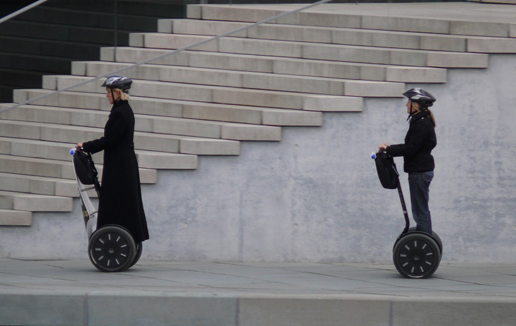 New technology has brought a number of power-driven devices not necessarily intended for people with disabilities, but are being used by some for mobility. ADA accessibility compliance regulations also apply to motorized mobility aids like the upright Segway.
New technology has brought a number of power-driven devices not necessarily intended for people with disabilities, but are being used by some for mobility. ADA accessibility compliance regulations also apply to motorized mobility aids like the upright Segway.
Take the following mini-exam based on the ADA’s compliance primer pamphlet for small business:
1. Businesses serving the public must allow people to use “other power-driven mobility devices” (like Segways and motorized personal carts) except when:
a. The device cannot be accommodated because of legitimate safety concerns..
b. The square footage of the business is such that use of the device cannot be accommodated.
c. Using the device could harm the environment or natural resources (on an ecologically fragile trail, for example).
d. All of the above.
2. Businesses can be reasonably expected to ban large golf carts, because of aisle size, etc. When would it be likely that many businesses will allow Segways?
a. During hours with busy customer traffic.
b. During days when business traffic might be heavier because of sales or special events.
c. Businesses never have to permit Segways on their premises.
d. During hours when customer traffic is expected to be light.
3. What doe s the ADA say about developing written policies when power-driven mobility devices will be permitted on the premises?
a. Businesses are only encouraged to develop written policies specifying when other power-driven mobility devices will be permitted on their premises.
b. Businesses are encouraged only to communicate their policies to the public.
c. The ADA is silent on this issue.
d. Businesses are encouraged to develop written policies specifying when other power-driven mobility devices will be permitted on their premises and to communicate those policies to the public.
4. A person is observed entering your business using a Segway or other power-driven device. What credible assurance should be accepted that the person actually needs the device because of a disability?
a. A valid State disability parking placard.
b. Another Federal or State-issued proof of disability.
c. A verbal assurance from the individual with a disability that is not contradicted by personal observation.
d. All of the above.
5. When is it permissible to ask an individual using a Segway or other power-driven device for specifics about their disabilities?
a. When it appears through observation that the individual has no disability.
b. When the individual tries to gain entrance to the business on a Segway only.
c. When the individual has absolutely no proof of disability.
d. It is never permissible to ask individuals about their disabilities.
Answer key: The answers to each multiple choice question above are all d.
Did you guess correctly on all of the above? We can help take the guess work out of ADA compliance. Contact us and learn about our full range of ADA compliance planning and advocacy services.
Image courtesy of Flickr, mompl
